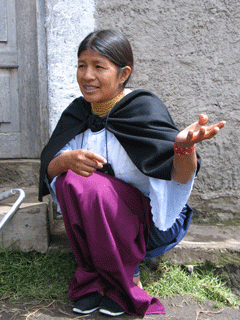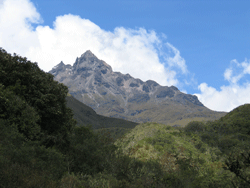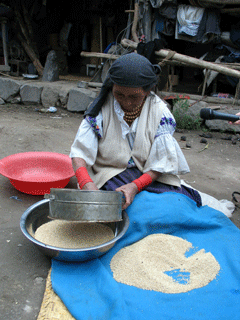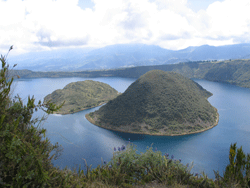Early Signs: Melting Ice Caps in Ecuador
Air Date: Week of April 7, 2006

Rosita Ramos tells stories about the Cotacachi mountain. (Photo: Pauline Bartolone)
This week we travel to the Ecuadorean Andes, to a snow-covered mountain that has been the source of legend for centuries. Now the glacier has melted, and the region's native people try to cope with a warmer, drier, world.
Transcript
CURWOOD: It’s Living on Earth. I’m Steve Curwood. Sometime in the last five years, the glacier atop a mountain in northern Ecuador vanished. It might seem paradoxical to have glaciers right at the equator, but the high altitude of the Andes Mountains has kept the peaks snowy year round for thousands of years – up until now.
Scientists say that 80 percent of Andean ice caps are likely to melt away in the next 15 years due to climate change. The glacier’s demise means less water and a changing way of life for the 30,000 mostly indigenous people who live in the foothills of Cotacachi Mountain. Their story is this week’s installment of our ongoing series, “Early Signs: Reports from a Warming Planet.”
The series is a collaboration of the UC-Berkeley Graduate School of Journalism, Salon dot com, and Living on Earth to document places around the world where concerns about climate change are already having an impact. Places like Cotacachi Mountain which was visited by producers Felicia Mello and Pauline Bartolone, who narrates our story.
[WOMAN SPEAKING SPANISH]

Rosita Ramos tells stories about the Cotacachi mountain. (Photo: Pauline Bartolone)
RAMOS: [VOICEOVER] For us, the mountain is not a volcano filled with lava or rocks. It’s full of grains and potatoes and all of the energy of the crops that we have here. We have a lot of contact with nature. Our parents always had a good communication with the land. And because of this communication they always had good harvests.
BARTOLONE: Wearing bright beaded jewelry, Rosita sits on a couch in the coolness of her simple concrete home. She has taken a break from the harsh midday sun that shines down on Cotacachi, a wide volcano rising to 16,000 feet, just 20 miles north of the equator.

The Cotacachi volcano, which lost its permanent snow cap at the turn of the century. (Photo: Felicia Mello)
RAMOS: [VOICEOVER] I remember when I was little, I would see Cotacachi after a snowfall and she would be covered with snow. And now I see her with very little snow. We had a creek right down there, a little waterfall. That’s where we would get water to drink and to wash our clothes. That waterfall was big, but now it’s really small.
[WALKING]
BARTOLONE: Indigenous people have shared stories about the mountain for generations. Lately their tales seem to hint at troubling changes. Rosita gathers those tales. She takes us across mountain canyons to a nearby town, where Maria Perugache is sifting quinoa on a blue blanket in front of her mud home.

Maria Perugache sifting quinoa in front of her home at the base of Cotacachi volcano. (Photo: Pauline Bartolone)
BARTOLONE: The two women talk in their native Quichua. Behind them, the bare brown peak of Mama Cotacachi pierces the clouds. Cotacachi is married to a nearby volcano, Perugache tells Rosita, but it hasn’t been a happy match.
RAMOS: [VOICEOVER] She says, “When they argue the thunderbolts fall, boom, boom. And that startles us, and we say ‘oh my God, they are fighting.’ And that makes us laugh.”
[LAUGHING]
BARTOLONE: In the legend, Cotacachi’s husband Imbabura cheated on her with Cayambe, a snow-covered mountain to the south.
RAMOS: [VOICEOVER] He gave Cotacachi grain. But he gave Cayambe the rain, the water. That’s why on that side they have water, and Cotacachi is starved of water.
BARTOLONE: Not everyone in Cotacachi’s 43 mountain villages has heard the term “global warming.” But, according to scientists, that’s exactly what’s contributing to changes in their communities. Temperatures have gone up by nearly three degrees Fahrenheit in the Ecuadoran Andes in the past half century.
For glaciers in the tropics, that can spell the difference between stability and retreat. Since the ice cap on Cotacachi disappeared five years ago, residents have fought over scarce water resources. Farmers are losing crops because they have little water to irrigate. People in Rosita’s community can no longer depend on local creeks.
[FOOTFALLS]
BARTOLONE: When Cotacachi was covered with snow and ice, meltwater from the glacier rushed down this canyon, Chumavi Creek, filling a lagoon below. Now, except when it rains, the creek is nothing but a winding path of weeds and stones.
[WALKING]
ZAPATA: [VOICEOVER] Everything that you see that looks like sand, that’s where the glacier used to be.
BARTOLONE: We walk the creek with Xavier Zapata, a water resources engineer who has studied the mountain.
ZAPATA: [VOICEOVER] Chumavi had water all the time because it was fed by the glacier. It’s part of a glacier’s hydrological balance: snow accumulates, it compacts, ice forms. There is an input and an output. But with climate change, the temperature is rising in the country. It affects the glaciers and they retreat. We’re now definitely in a time when the glacier has disappeared and is no longer feeds the rivers.
[ROCK CLIMBING]
BARTOLONE: Chumavi isn’t the only creek with a problem. All over the mountain, says Zapata, rivers and streams are getting smaller.
ZAPATA: [VOICEOVER] The scary part is all these communities that you see get their water from the rivers. And when there isn’t any water in the rivers, I can’t imagine the disaster we would see.
[ANCHOR RELEASING. BOAT MOTOR. LAPPING WATER]
BARTOLONE: Halfway down the mountain, a crater holds a deep blue lagoon with two small islands at its center. Motorboats whiz by as tourists line up waiting to take a ride on the lagoon’s clear waters.
[SEVILLANO TAKING MONEY FROM CUSTOMERS]
BARTOLONE: Marcelo Sevillano has helped run a family boat tour business since he was a teenager.
[ANCHOR RELEASE. GUNNING MOTOR]
BARTOLONE: He fires up the motor and ferries a group of travelers toward one of the islands.
[BOAT SLOWING]
BARTOLONE: There he stops and tells a few chapters from his family’s collection of local folklore.

Laguna Cuicocha, a crater lake on the Cotacachi volcano. (Photo: Felicia Mello)
BARTOLONE: Sevillano worries that environmental changes are threatening the lagoon. Years ago, shamans would perform rituals at the base of a waterfall fed by Chumavi Creek. But today that waterfall is gone. And the lake, which once collected runoff from the glacier like a giant sink, is slowly being drained.
[WATER LAPPING]
BARTOLONE: Over the past decade, the water level in the stadium-sized lagoon has gone down over ten feet. Twice, the boat company has had to lower the dock to reach the receding tide.
SEVILLANO: [VOICEOVER] We are talking about a huge amount of water. It’s obviously a problem that worries us, but its not just here. This is at a global level. What’s influencing it is global warming. Cotacachi has no snow. It wasn’t like that 15-20 years ago.
[WATER]
BARTOLONE: Water from Laguna Cuicocha seeps through mountain crevices to springs farther down the mountain, where farmers use it to irrigate their crops.
At this large commercial farm, Hacienda La Maria, eucalyptus trees give shade to plots of organic vegetables, where women in head-scarves move quietly down the rows. A farm worker named Juan Espin shows us the reservoir that feeds these crops, a small pond covered with algae.
ESPIN: [VOICEOVER] The water always comes in here, and it is stored there, and then, when it’s necessary, we open the gates and irrigate.
BARTOLONE: The shrinking water supply has forced this farm to come up with new ways to manage water. But they still have only enough to plant half their land. Espin has lived in this highland community all his life, and says farming didn’t used to be so difficult.
ESPIN: The water has decreased tremendously. You used to have year-round springs. I’m from here in Imantag and I remember that the springs that we had here were abundant. They supplied the whole community. But five years ago, the water dried up.
BARTOLONE: With less water from the mountain, the hacienda is more dependent on the rain.
ESPIN: [VOICEOVER] Sometimes we have to play a guessing game – gee, is it going to rain or isn’t it? Should we plant or not? It’s a risk sometimes to plant because you don’t know if the rain is going to come.
BARTOLONE: So, both the rain and glacial runoff have become uncertain. Rain falls in strange patterns these days, and some residents say the seasons are playing with them. Scientists haven’t established the cause of these changes. But the complaints echo predictions of the world’s best-known climate authority, the Intergovernmental Panel on Climate Change, that global warming may bring more irregular weather to Latin America.
[RAKING SOUND]
BARTOLONE: The dry spells have affected villages farther down the mountain, like this one, where 73-year-old Segundo Alfredo Tabango is raking alfalfa.
TABANGO: [VOICEOVER] It’s been really hard for us for several years with the drought. When it doesn't rain, time passes and we can't plant. The summers have been very long. The plants, even the corn, they’re all dried up.
BARTOLONE: Tabango says diseases have struck his weakened plants. His father never used farm chemicals, but, Tabango says, now he has no choice.
TABANGO: [VOICEOVER] If you don’t spray right away, you lose the whole crop. We don’t know what else to do.
BARTOLONE: With an unpredictable rainy season, the land does not yield enough to support everyone. People are beginning to make different life plans. Tabango says his three sons choose to drive taxis in a nearby city. And Tabango says he and his wife now sometimes go hungry because when crops fail they have nothing to exchange for staples like salt, sugar, and rice.
TABANGO: [VOICEOVER] When there isn't money, you just have to do without. If you eat lunch, you don’t have dinner. If you have coffee, you don’t have lunch. Or if you have lunch, you have just coffee for your dinner, nothing else.
BARTOLONE: Drought hit hard throughout Ecuador last year, forcing the government to declare a state of emergency and import energy from longtime rival Peru. Production was down by a third at the nation’s largest hydroelectric plant, and, on the coast, desperate people dug their own wells to search for water.
Scientists say you can’t link a particular drought to global warming. But Julio Cornejo sees both the drought and glacial retreat as part of the same disturbing picture. He’s the chief of Ecuador’s new climate change program within its environmental ministry. He says the country must learn to manage its water better before it’s too late.
CORNEJO: [VOICEOVER] Global warming is not the fault of third-world countries. We are dancing at a party that we didn’t even want to attend. But we are beginning to change our habits anyways, and we’ll have to keep doing that. If we don’t, climate change will grab hold of us and we will disappear.
BARTOLONE: When she’s not working or taking care of her four children, Rosita Ramos visits neighbors and often hears their stories about Mama Cotacachi. She’s heard scientists talk about global warming, but Rosita has a different explanation for the changes in the mountain.
RAMOS: [VOICEOVER] For me it’s because people here no longer have the same respect as before. Before, we respected Mother Earth, the plants, the animals and all of nature. Picking a plant was something sacred. Tearing the earth to make an irrigation canal was like killing a person. But the young people don’t maintain the culture, not even my children! They go to work in the city and come back with other ideas. For them our stories are only fairy tales.
BARTOLONE: Toward the end of our time in Cotacachi, Rosita takes us to a nearby village to visit a yacha, a Quichua spiritual leader. His name is Don Jose Maria Montalvo, and he uses herbs and prayers to cure patients in the patio of his tile-roofed home.

Shaman Jose Maria Montalvo in front of his home in Morales Chupa, Ecuador. (Photo: Pauline Bartolone)
BARTOLONE: He comes out to meet us in a tattered sweater and sweatpants, holding a glass ball that he says is made of ice from the mountain. The shaman’s eyes are tired. As Rosita translates, he says he draws his powers from Cotacachi. But lately, their relationship is changing.
[SHAMAN COUGHING]
RAMOS TRANSLATING MONTALVO: [VOICEOVER] Before, I could enter into the mountain, he says. She would come to me. But now it’s not the same. I can feel her energy pulling away. So I see that Cotacachi is different. I don’t know if other people see this, but I, who have worked with the mountains, this is what I see.
BARTOLONE: The shaman says the mountain is responding to changing cultural ways. In a dream, Cotacachi showed him that people were burning the grass on her slopes.
RAMOS TRANSLATING MONTALVO: [VOICEOVER] And Cotacachi said to him ‘I’m burnt, look how they have burned all my skirts.’ And since then he sees that the water is going away. The rain is decreasing. The weather also is changing. And finally he realized that his energy is disappearing, too.
BARTOLONE: The view from one small corner of the Andes, where memory stretches back a long way. But not long enough to remember a mountain with no snow.
[MUSIC: Inti Raymi (Unknown song/Unknown album)]
CURWOOD: Our story on Cotacachi Mountain was produced by Pauline Bartolone and Felicia Mello as part of our ongoing series “Early Signs: Reports from a Warming Planet.”
Next week, we go to the South Pacific to the island nation of Kiribati, where some residents say they’re already beginning to notice beach erosion and salty drinking water that scientists predict will only get worse as the sea level rises.
MAN: When their government looks ahead, say, 100 years, 200 years, you know, there’s a pretty good chance those islands won’t even exist.
CURWOOD: “Early Signs” is a collaboration of the UC-Berkeley Graduate School of Journalism, Salon dot com and Living on Earth. To see photos and read a print version of the story about Cotacachi Mountain, visit our website, Living on Earth dot org. That’s Living on Earth dot O-R-G.
 |
 |  |  |
Links
To see a print version of this story, and other reports in this series, click here
Living on Earth wants to hear from you!
Living on Earth
62 Calef Highway, Suite 212
Lee, NH 03861
Telephone: 617-287-4121
E-mail: comments@loe.org
Newsletter [Click here]
Donate to Living on Earth!
Living on Earth is an independent media program and relies entirely on contributions from listeners and institutions supporting public service. Please donate now to preserve an independent environmental voice.
NewsletterLiving on Earth offers a weekly delivery of the show's rundown to your mailbox. Sign up for our newsletter today!
 Sailors For The Sea: Be the change you want to sea.
Sailors For The Sea: Be the change you want to sea.
 The Grantham Foundation for the Protection of the Environment: Committed to protecting and improving the health of the global environment.
The Grantham Foundation for the Protection of the Environment: Committed to protecting and improving the health of the global environment.
 Contribute to Living on Earth and receive, as our gift to you, an archival print of one of Mark Seth Lender's extraordinary wildlife photographs. Follow the link to see Mark's current collection of photographs.
Contribute to Living on Earth and receive, as our gift to you, an archival print of one of Mark Seth Lender's extraordinary wildlife photographs. Follow the link to see Mark's current collection of photographs.
 Buy a signed copy of Mark Seth Lender's book Smeagull the Seagull & support Living on Earth
Buy a signed copy of Mark Seth Lender's book Smeagull the Seagull & support Living on Earth

